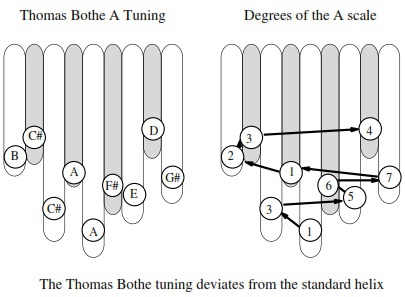
Use of this website constitutes acceptance of the Privacy Policy and User Agreement. Copyright © 2020 Kalimba Magic. All Rights Reserved.
The Hokema Sansula come in the standard A minor tuning or in any of the alternative tunings. We present a few purely geometrical ways of thinking about the Sansula tunings. We also introduce a new alternative Sansula tuning based on my favorite Thomas Bothe tuning.
One of the features of the Sansula is that whatever you play on it, it sounds beautiful. On the other hand, when I play, I want my music to be more than my thumbs blindly twiddling – I want real ideas and real feelings and real music.
I was recently playing six different Sansulas, each in a different tuning, for one video. I invented most of those tunings. But I still became hopelessly confused switching among them.
And then I realized that there is a simple way to orgnize and understand the basic shape of each of these tunings – a “pitch helix”, a twisting spiral pattern that leads you back and forth across the tines, as you move up the scale. Most of the Sansula tunings that we sell pretty much follow this pattern: a basic oscillation from right to left, starting out tight, expanding wider, and then starting to get tighter at the top. In the middle, the oscillation gets stuck and sweeps across the tines labeled “3, 4, 5, 6”. These numbers do not represent the degrees of the scale, but only indicate a sequence, in order of lowest to highest.
So, I keep that helix shape in my mind when I hold these differently tuned Sansulas in my hands, and that gives me something to help organize my playing.
Another thing I often do on kalimbas to help me find my way is to put a small black Sharpie pen dot on the root note/s on the kalimba, so I know where “home base” is – a place to return after I have journeyed through the music.

This is the same relative tuning that I found on the very first kalimba Thomas Bothe sent me, and is in the music sample you can click on at the bottom of this page. The odd thing about this tuning is that it deviates from the pitch helix pattern. It makes an extra zig to the right, and make a less organized path than the other tunings make.
I find playing on the new Thomas Bothe tuning to be very intuitive, so there is a lot more going on than just the complex zig-zag. In fact, when I play this tuning, I feel the tines in layers!

This diagram shows another way of thinking about the tines. I no longer care specifically about which note is higher or lower – I care about which notes go together. The lower row tines make one layer of notes that work together (chord-wise it is an A Maj 9 chord, or an A triad with an E triad on top) and the upper row of tines makes another layer of notes that work together (it is a D Maj 7 chord).
It really doesn’t matter how you think about the tines and their relationships. Probably the best thing for you to do is to create your own meaning, your own designs, your own mythology about how the notes work together. You don’t have to take mine – but let these ideas be examples to you for how you can create your own organizing principles to understand the kalimba. That will make the journey that much more personal to you.


Sign up for our newsletter and free resources with your email address:
We pinky promise not to spam you and to only send good stuff.
 Assist Paul Tracey Rebuild His House in Pacific Palisades
Assist Paul Tracey Rebuild His House in Pacific Palisades 8-Note Spiral Kalimba Turned into a Student Karimba
8-Note Spiral Kalimba Turned into a Student Karimba Seek to Infuse Your Musical Moments With Beauty and Magic
Seek to Infuse Your Musical Moments With Beauty and MagicUse of this website constitutes acceptance of the Privacy Policy and User Agreement. Copyright © 2020 Kalimba Magic. All Rights Reserved.